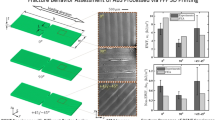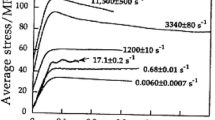Abstract
An experimental study is performed to investigate the dynamic fracture of additive manufactured Acrylonitrile Butadiene Styrene (ABS). A single edge notched bending (SENB) specimen with three orientations, namely horizontal builds with 45°/−45° (H45), 0°/90° (H90) raster orientations, and vertical builds with layers perpendicular to the pre-crack (V0) are considered for this study. In addition, a novel toughening mechanism is explored by changing the surface topology to deflect the crack paths. A modified split Hopkinson pressure bar with a copper pulse shaper (to increase the raising time of incident loading pulse) is used to conduct a three-point bend impact experiment to characterize the dynamic fracture initiation toughness and crack dynamics of 3D printed specimens. Real-time crack initiation and propagation is captured by using a high-speed video camera. Using the load history diagram, accurate fracture initiation load is found to determine dynamic fracture initiation toughness. Fracture initiation toughness is increased by 138% for a V0 specimen configuration compared to H90. Three different sized circular patterns (with diameters of 1, 1.75 and 2.5 mm) and a square pattern (with a length of 1.53 mm) are considered to observe the effect of surface topology on the dynamic fracture initiation toughness. Introducing surface pattern to the specimen increases the fracture toughness by 58% as compared to specimens without surface pattern. Surface pattern also exhibits two steps of crack growth and decreases the initial crack propagation velocity significantly for all three orientations. Additionally, higher fracture initiation toughness is achieved with the increase in the size of the pattern and the change of the pattern shape.














Similar content being viewed by others
References
Agrawal M, Jamalabad VR, Langrana NA, Safari A, Whalen PJ, Danforth SC (1996) Structural quality of parts processed by fused deposition. Rapid Prototyp J 2:4–19
Ahn SH, Montero M, Odell D, Roundy S, Wright PK (2002) Anisotropic material properties of fused deposition modeling ABS. Rapid Prototyp J 8:248–257
Carneiro OS, Silva AF, Gomes R (2015) Fused deposition modeling with polypropylene. Mater Des 83:768–776
Kruth JP, Leu MC, Nakagawa T (1998) Progress in additive manufacturing and rapid prototyping. CIRP Ann 47:525–540
Huang SH, Liu P, Mokasdar A, Hou L (2013) Additive manufacturing and its societal impact: a literature review. Int J Adv Manuf Technol 67:1191–1203
Guo N, Leu MC (2013) Additive manufacturing: technology, applications and research needs. Front Mech Eng 8:215–243
Leon AC, Chen Q, Palaganas NB, Palaganas JO, Manapal J, Advincula RC (2016) High performance polymer nanocomposites for additive manufacturing applications. React Funct Polym 103:141–155
Bellini A, Guceri S (2003) Mechanical characterization of parts fabricated using fused deposition modeling. Rapid Prototyp J 9:252–264
Lee CS, Kim SG, Kim HJ, Ahn SH (2007) Measurement of anisotropic compressive strength of rapid prototyping parts. J Mater Process Technol 187–188:627–630
Masood SH, Mau K, Song WQ (2010) Tensile properties of processed FDM polycarbonate material. Mater Sci Forum 654–656:2556–2559
Hossain MS, Espalin D, Ramos J, Perez M, Wicker R (2014) Improved mechanical properties of fused deposition modeling-manufactured parts through build parameter modifications. J Manuf Sci Eng 136:061002
Zhong W, Li F, Zhang Z, Song L, Li Z (2001) Short fiber reinforced composites for fused deposition modeling. Mater Sci Eng 301:125–130
Masood SH, Song WQ (2004) Development of new metal/polymer materials for rapid tooling using fused deposition modelling. Mater Des 25:587–594
Weng Z, Wang J, Senthil T, Wu L (2016) Mechanical and thermal properties of ABS/montmorillonite nanocomposites for fused deposition modeling 3D printing. Mater Des 102:276–283
Gardan J, Makke A, Recho N (2016) A method to improve the fracture toughness using 3D printing by extrusion deposition. Procedia Struct Integrity 2:144–151
Aliheidari N, Tripuraneni R, Ameli A, Nadimpalli S (2017) Fracture resistance measurement of fused deposition modeling 3D printed polymers. Polym Test 60:94–101
Hart KR, Wetzel ED (2017) Fracture behaviors of additively manufactured acrylonitrile butadiene styrene (ABS) materials. Eng Fract Mech 117:1–13
Nwosua SN, Huib D, Dutta PK (2003) Dynamic mode II delamination fracture of unidirectional graphite/epoxy composites. Compos Part B 34:303–316
Kolsky H (1949) An investigation of the mechanical properties of materials at very high rates of loading. Proc Roy Soc London Ser A 11:676–700
Riddick JC, Haile MA, Wahlde RV, Colen DP, Bamiduro O, Johnson TE (2016) Fractographic analysis of tensile failure of acrylonitrile-butadiene-styrene fabricated by fused deposition modeling. Addit Manuf 11:49–59
Owolabi G, Peterson A, Habtour E, Riddick JC, Coatney M, Olasumboye A, Bolling D (2016) Dynamic response of acrylonitrile butadiene styrene under impact loading. Int J Mech Mat Eng 11:3
Dai F, Chen R, Xia K (2010) A semi-circular bend technique for determining dynamic fracture toughness. Exp Mech 50:783–791
Gao G, Huang S, Xia K, Li Z (2015) Application of digital image correlation (DIC) in dynamic notched semi-circular bend (NSCB) tests. Exp Mech 55:95–104
Anderson TL (2005) Fracture mechanics: fundamentals and applications, 3rd edn. CRC Press, Boca Raton, p 52. 1995
Jiang F, Liu R, Zhang X, Vecchio KS, Aashish R (2004) Evaluation of dynamic fracture toughness KId by Hopkinson pressure bar loaded instrumented Charpy impact test. Eng Fract Mech 71:279–287
Stalder B, Kausch H (1985) The use of a velocity gauge in impact testing of polymers. J Mater Sci 20:2873–2881
Kidane A, Shukla A (2010) Quasi-static and dynamic fracture initiation toughness of Ti/TiB layered functionally graded material under thermo-mechanical loading. Eng Fract Mech 77:479–491
Koohbor B, Kidane A, Sutton MA (2016) Analysis of dynamic bending test using ultra high speed DIC and the virtual fields method. Int J Impact Eng 110:299–310
Abbott AC, Tandon GP, Bradford RL, Koerner H, Baur JW (2018) Process-structure-property effects on ABS bond strength in fused filament fabrication. Addit Manuf 19:29–38
Acknowledgments
The authors acknowledge the financial support of DURIP grant (W911NF-17-1-0192) to acquire high speed camera.
Author information
Authors and Affiliations
Corresponding author
Additional information
Publisher’s Note
Springer Nature remains neutral with regard to jurisdictional claims in published maps and institutional affiliations.
Rights and permissions
About this article
Cite this article
Rabbi, M., Chalivendra, V. & Li, D. A Novel Approach to Increase Dynamic Fracture Toughness of Additively Manufactured Polymer. Exp Mech 59, 899–911 (2019). https://doi.org/10.1007/s11340-019-00486-3
Received:
Accepted:
Published:
Issue Date:
DOI: https://doi.org/10.1007/s11340-019-00486-3




